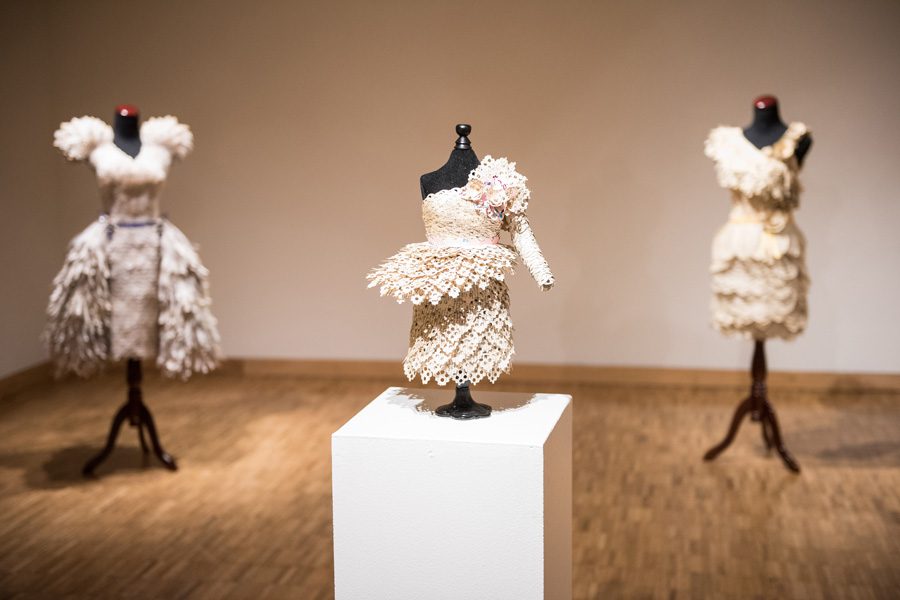Latest Dittmar exhibit breaks down traditional ideas of femininity
Matt Zients/The Daily Northwestern
Dittmar Gallery’s new exhibit features dresses made of pages from romance novels. The dresses are a statement on feminine myths in society.
October 26, 2016
A&E
Artist Carrie Ann Schumacher seeks to deconstruct gender roles in the most literal way possible: by ripping pages out of romance novels that she believes fit women into stereotypical boxes.
Schumacher’s exhibit, “Build Her a Myth,” opened Friday in Norris University Center’s Dittmar Gallery and will be on display until Dec. 4. It features intricate dresses made out of pages taken from romance novels, all hand-cut and glued together by Schumacher, a Chicago-based artist and teacher at College of DuPage.
The dresses are a statement on the “myths of womanhood” perpetuated in our culture, Schumacher said. The medium of the pages and the words inscribed on them are meant to comment on the unrealistic expectations and gender roles that place demands on women.
“(The dresses) are really these useless things that are going to fall apart and disintegrate over time, like all these ideas that we sell ourselves,” the artist said.
Both the fashion industry and romance novels are responsible for perpetuating these myths, Schumacher said. Magazines establish restrictive beauty standards, and romance novels create images of perfect relationships that do not reflect reality, she said.
Gallery curator Joy Kim said “Build Her a Myth” is part of Dittmar’s first season in recent history that features only female artists. She thought the exhibit was fitting with the student-run gallery’s mission of highlighting underrepresented voices in the arts.
“It’s a very unique take on femininity, what defines femininity and putting it in a historical context,” the Communication junior said.
Although her dresses are still clearly feminine, Schumacher said she has been incorporating more of a “warrior” look into her work. The newer dresses appear sharper and more protective because she developed them as a response to feeling attacked both in her art and in her personal life.
She added that being a target of negative criticism is a common theme for many women, whether they are in the public eye or not.
For each dress, Schumacher said she first creates a supportive understructure, usually from flattened cereal boxes or paper towel tubes. She then cuts pages from novels by hand and glues them onto the structure. The process can take anywhere from a few days to three or four weeks, she said, depending on the size and complexity of the dress.
Although she usually has a basic idea of what the dress will look like, Schumacher said she often ends up improvising the details. Sometimes the paper will also morph and lie differently than how it was originally placed on the understructure, she said.
Weinberg sophomore Rachana Kolli, who visited the exhibit, said she believes its feminist message is important for everyone to understand and thinks the dresses are an effective medium for expressing it.
“It communicates the message in an accessible way,” Kolli said.
Kim said visitors to the exhibit have not been exclusively women. Many were drawn initially by the “aesthetic” of the dresses, she said, but were then prompted into engaging in dialogue about the underlying themes.
In tackling gender roles, Schumacher acknowledged that there is a fine line between demanding change in society and pressuring women to change themselves. She added that women should not feel the need to reject their femininity but should instead push for a society that accepts different forms of womanhood.
“You don’t want to define womanhood in one way,” Schumacher said. “You want it to be more open, where people can find it for themselves.”
Email: [email protected]
Twitter: @madsburk


